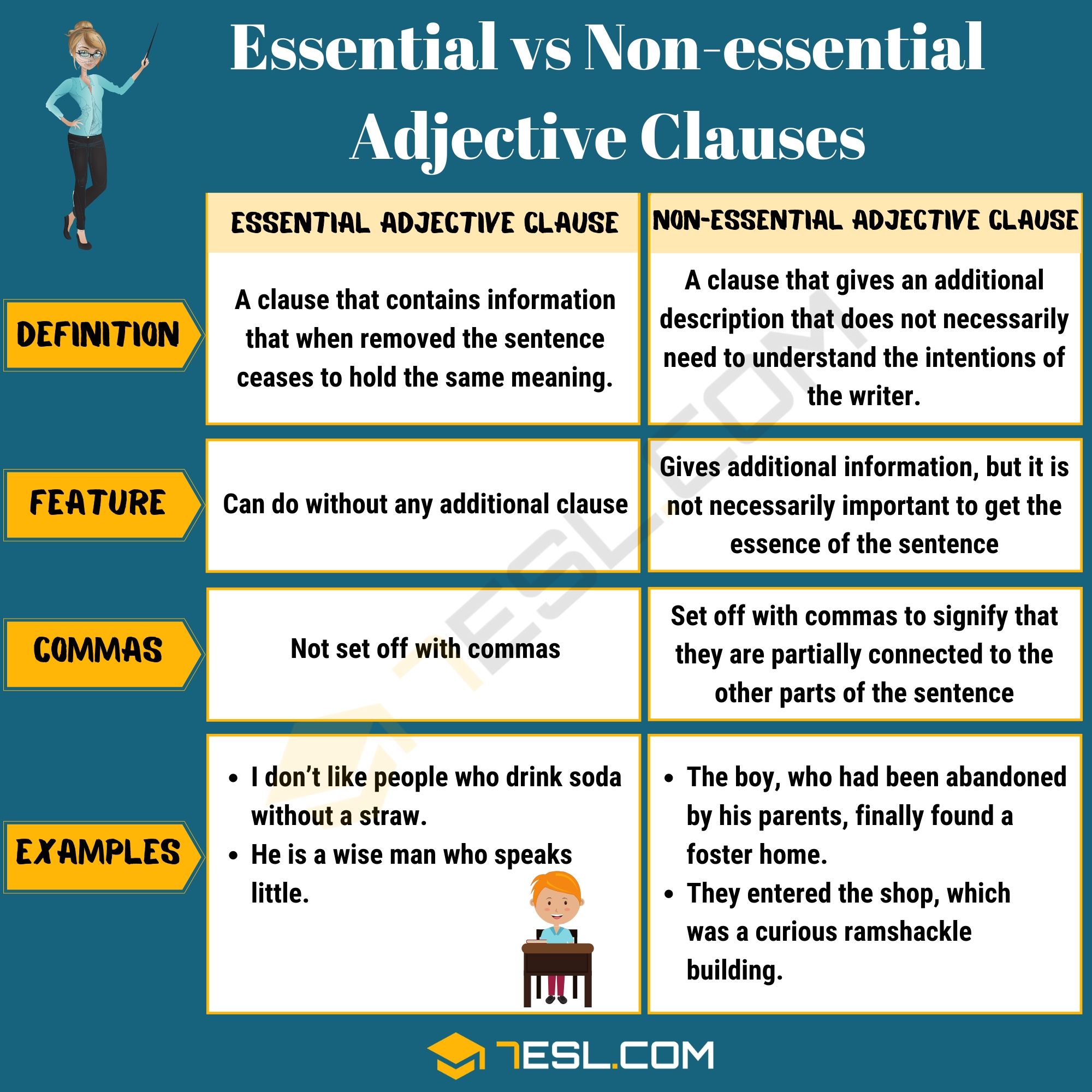What is an adjective clause? Learn the adjective clause definition and useful grammar rules to use adjective clauses in English sentences with useful examples.
Adjective Clause
What Is an Adjective Clause?
To understand what an adjective clause is, we need to define the two words separately.
An adjective is a word that tells more information about a noun. A clause is a multi-word that features a subject and a verb. A sentence is considered complete if the clause expresses a complete thought. If it doesn’t, then it is referred to as dependent a clause because it depends on the main clause of the sentence to express a complete thought. In other words, an adjective clause is a multi-word that contains a subject and a verb that tells more information about a noun in a sentence. Adjective clauses depend on other clauses in a sentence to express a complete thought, and that’s why they are referred to as dependent clauses.
Relative Pronouns Can Introduce Adjective Clauses
All adjective clauses begin with a relative pronoun. Some of the most used relative pronouns include: who, whose, which, whoever, whomever, that, and where.
Relative pronouns mark the beginning of an adjective clause in a sentence. Here the most important thing is to spot a relative pronoun because adjective clauses follow them. They function as actual subjects and at times the objects in the adjective clauses.
Examples of adjective clauses in a sentence include:
- People who are true patriots love their country unconditionally.
- I can recall the time when there were no mobile phones.
- Jason has a relative whose daughter pursues a career in nursing.
- Dancing, which many people love, is tiresome.
- The reason why David skips mathematics lessons is that he doesn’t love the subject.
- The reason why Nicolas prefers to watch football matches is that he doesn’t like to watch basketball.
- Weddings, which are hosted in secluded areas, are very jovial.
Note that all the adjective clauses in the above examples begin with a relative pronoun. This links them to the nouns being modified, which comes at the start followed by a relative pronoun in the sentence.
Each of the adjective clauses in the above examples has a subject and a verb, and the two work together to modify the original noun. For instance, the clause which many people love has the subject “people” and the verb “love,” yet it is not a complete sentence by itself. Instead, its primary function is to give more information about the noun “dancing.”
There are some cases where the relative pronoun acts as a subject of the clause. In the adjective clause who are true patriots “who” is the relative pronoun and at the same time functions as the subject that is patriots.
Adjective Clauses
Essential Adjective Clauses
Essential adjective clauses are clauses that contain information that when removed the sentence ceases to hold the same meaning. An example of this might be:
- I don’t like people who drink soda without a straw.
Here the adjective clause gives vital information to describe the people. If you can remove the adjective clause, then the remaining sentence would state “I don’t like people” which is different from not liking people who drink soda without a straw. An essential adjective clause can do without any additional clause.
Non-essential Adjective Clauses
A non-essential adjective clause is a clause that gives an additional description that does not necessarily need to understand the intentions of the writer. The following is an example:
- The boy, who had been abandoned by his parents, finally found a foster home.
Here the adjective clause gives additional information, but it is not necessarily important to get the essence of the sentence about the boy finding a home.
Unlike essential adjective clauses that are not set off with commas, non-essential adjective clauses are set off with commas to signify that they are partially connected to the other parts of the sentence.
The addition of adjective clauses to your writing is an effective way of providing extra information about the pronouns and nouns in your writing. The additional description is meant to enhance your writing and help the readers quickly grasp the message you are trying to pass.
When informed about the relative pronouns and how to differentiate essential clauses from non-essential clauses, you will find it easy to identify adjective clauses and punctuate them appropriately in your writing. You should also be in a position to differentiate between dependent and independent adjective clauses.
Essential and Non-essential Adjective Clauses | Image








0 Comments